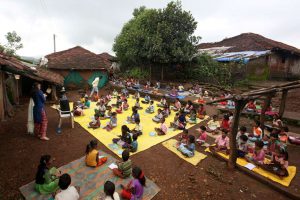AUGUST 4, 2020

Children, who have missed online classes due to a lack of Internet access, listen to prerecorded lessons over loudspeakers, in Maharashtra, India, on July 28. (Prashant Waydande/Reuters)
The world is facing a “generational catastrophe” due to ongoing school closures, U.N. Secretary General António Guterres warned Tuesday, calling the coronavirus pandemic “the largest disruption of education ever.”
Allowing students to safely return to classrooms must be a “top priority” as countries get local transmission under control, Guterres said in a video message released early Tuesday morning.
A policy brief published alongside Guterres’s message emphasized that suppressing transmission of the virus is “the single most significant step” leaders can take toward reopening schools.
Guterres’ comments come as countries around the world wrestle with how to keep students engaged while limiting the risk of coronavirus transmission and as parents struggle with child-care challenges.
As of Aug. 2, more than 1 billion students in more than 160 countries were affected by school closures, according to data collected by the U.N. Educational, Scientific and Cultural Organization, and more than 40 million children had missed out on the “critical preschool year,” Guterres said. Countrywide closures remain in place in 106 countries.
Prolonging that pause “could waste untold human potential, undermine decades of progress and exacerbate entrenched inequalities,” he said.
Guterres noted that parents, and particularly women, “have been forced to assume heavy care burdens in the home” as schooling moves online. Meanwhile, refugees, students with disabilities and people who live in remote areas are less likely to be able to access virtual instruction.
In parts of Europe and Asia, where strict lockdowns and other measures helped lower coronavirus case counts, some schools have already reopened, often with extra precautions in place to limit the possibility of transmission between children. In Germany, a phased reopening of schools began Monday.
But U.S. educators reluctant to dive into in-person learning have pointed to these countries as examples of places where case numbers were generally far more under control than they currently are in much of the United States, where more than 4.7 million cases and 152,000 deaths have been confirmed thus far.
American schools typically reopen in August and early September after summer holidays, and the White House is pushing for districts to launch in-person learning even as cases surge across much of the country.
“OPEN THE SCHOOLS!!!” President Trump tweeted late Monday.
Nationally, school districts are taking a variety of approaches toward the coming academic year. Some are planning to reopen in person, others are opting entirely for online learning and some plan to use a mix of the two.
Many educators and parents say there is no right option for students.
Teachers and staff have expressed fears that resuming in-person learning will lead to widespread outbreaks. Educators also worry some students, especially those in low-income families, will not have the tools they need — including steady electricity, WiFi and computers — to adequately engage with remote learning. But those students are often already coming from communities disproportionately affected by the pandemic, adding to concerns that returning to in-person learning could lead to upticks in cases.
Concerns school closures will exacerbate existing inequalities go far beyond the United States.
In wealthy nations, school closures were a major disruption but were made more manageable by widespread Internet access that allowed students to connect directly with teachers and maintain some semblance of normalcy.
But in countries like Pakistan, where WiFi access is far more limited, the government set up a television channel for remote learning that students from kindergarten through high school watched in one-hour shifts.
Courtesy/Source: Washington Post










































































































